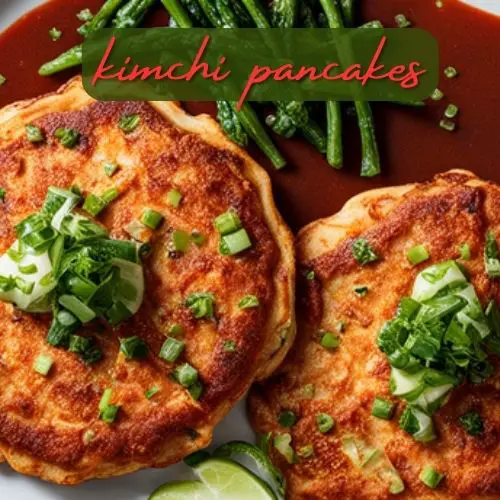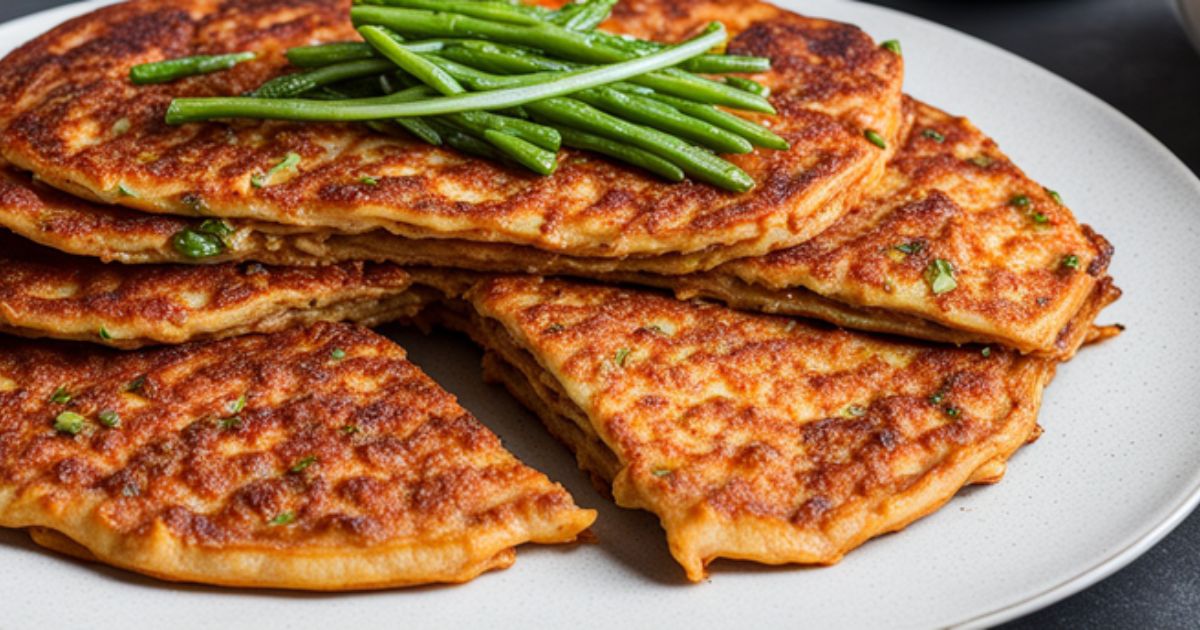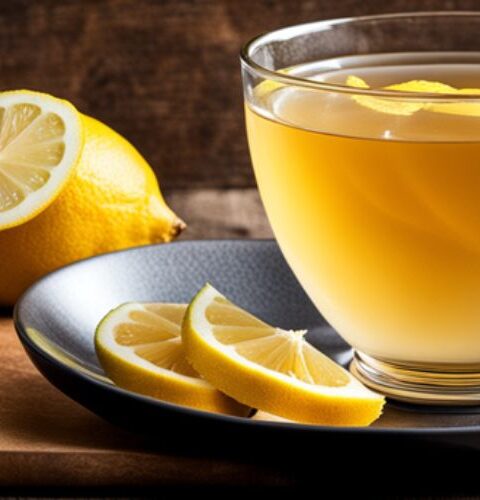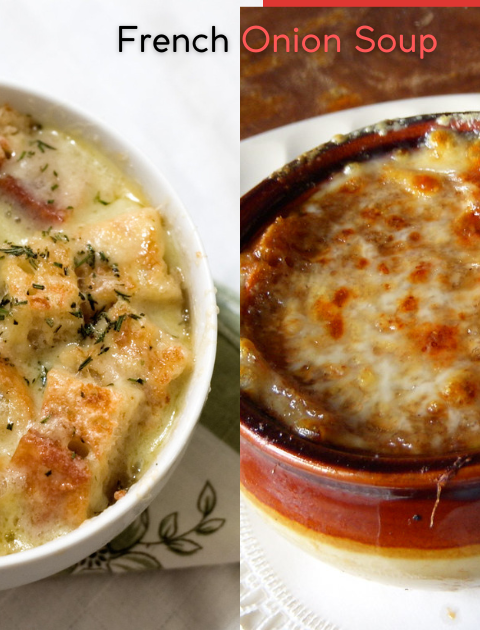Exploring the Irresistible Delight of Kimchi Pancakes
Kimchi pancakes are a fusion of traditional Korean flavors and the comforting familiarity of pancakes. Originating from ancient Korea, kimchi is a method of preserving vegetables, especially cabbage, by fermenting them with spices. The concept of incorporating kimchi into pancakes emerged as a creative way to use up leftover kimchi or add flavor to a familiar dish. Over time, kimchi pancakes have become a popular street food and a favorite comfort food in Korea.
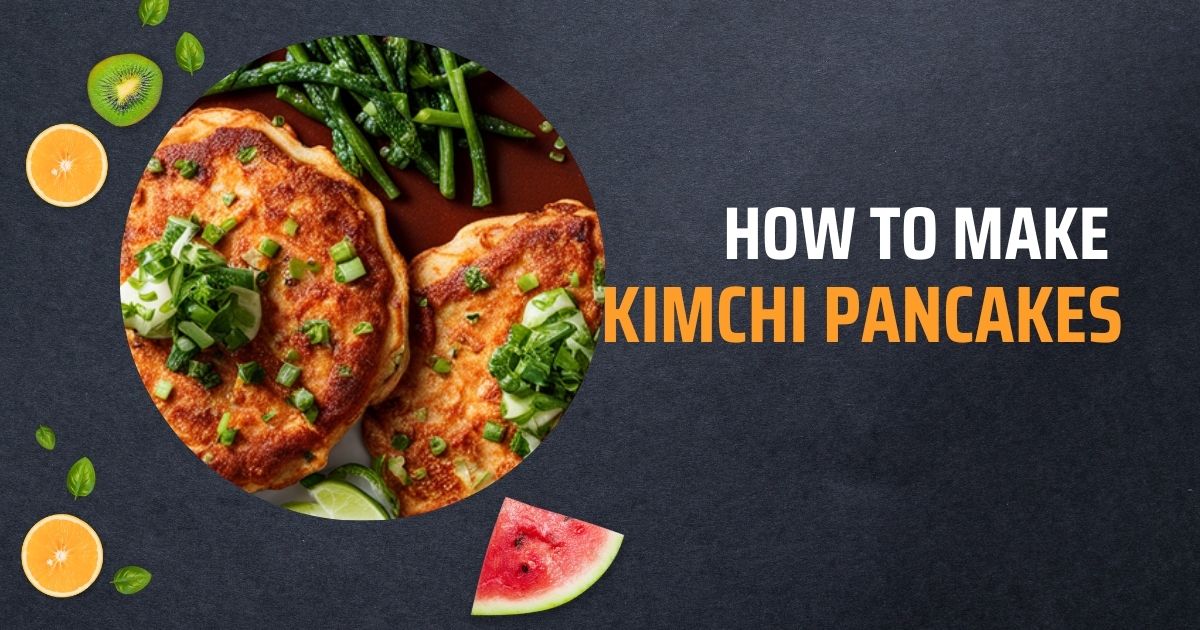
What is kimchi?
- Kimchi, a traditional Korean dish, is a delicious and versatile fermented delight. Here’s everything you need to know about it:
- 1. Ingredients:
Kimchi usually includes a combination of:
Vegetables: cabbage (most common), carrots, radishes, cucumbers and scallions.
Seasonings: garlic, ginger, chili pepper, salt and fish sauce.
The mixture is pickled and fermented. It was originally used to preserve vegetables during the winter months. - 2. Flavor Profile:
The flavor of kimchi is “complex” and varies depending on the recipe.
Key Flavor Notes:
Sour: Lactic acid from fermentation creates a tangy, sauerkraut-like flavor.
Spicy: It depends on the amount and type of pepper used.
Umami: Ingredients such as fish paste or fish sauce contribute to this savory note. - 3. Uses:
Side Dish: Eaten by itself as a side dish or appetizer.
Ingredient: Kimchi is used in a variety of dishes such as jjigae (a stew), fried rice, stir-fries, noodles, sandwiches and pizza.
Spices: Add flavor to food.
Dipping: Combine it with other foods. - 4. Nutritional Benefits:
Kimchi is a fermented food rich in probiotics.
It is commercially available, but it can be fun to make at home.
Economical, versatile and easy to prepare.
the distinction between sauerkraut and kimchi
Let’s explore the differences between kimchi and sauerkraut, two delightful fermented cabbage dishes:
1. Ingredients and Origin:
- Kimchi:
Origin: Kimchi is from Korea.
Ingredients: It mainly consists of napa cabbage, garlic, ginger, chili pepper, salt, spring onion and jyotgal (fermented seafood), along with seasonings.
Taste: Kimchi has a wide range of flavors, varying from sour to spicy and salty. - Sauerkraut:
Origin: Sauerkraut has its roots in China.
Ingredients: It mainly uses green or red cabbage and salt.
Taste: Traditional sauerkraut is sour and pungent.
2. Taste and texture:
- Kimchi:
Salt: Kimchi is salty.
Crunchier: It retains more crunch.
Less acidic: Kimchi is less acidic than sauerkraut. - Sauerkraut:
Sour: Sauerkraut has a pronounced sourness.
Texture: It has a firmer texture.
3. Additional Notes:
- Umami: Kimchi has a distinct umami flavor due to ingredients such as fish sauce or fermented seafood.
Acidity: Sauerkraut is more acidic without the umami notes found in kimchi. - In summary, while both are fermented cabbage dishes, kimchi offers a broader flavor spectrum, while sauerkraut leans toward sour simplicity. Enjoy exploring these culinary wonders!
How long does it take to make kimchi?
Kimchi, the beloved Korean fermented dish, is a delightful blend of spicy, tangy and umami flavors. The time it takes to make kimchi depends on your desired flavor and patience level. Let’s explore the process of fermentation:
1. Preparation:
- Cut a medium head of napa cabbage into quarters.
- Cut each quarter into strips or cubes.
- Toss the cauliflower with kosher salt and let it sit for 1 to 2 hours.
- Rinse the cabbage and drain it in a colander.
2. Taste Development:
- Quick Kimchi (fresh and tangy):
- Ready to eat immediately.
- Ferment for a few days.
- Still crisp with a tangy flavor.
- Traditional Napa Cabbage Kimchi:
- Can be eaten immediately or left to ferment.
- Ferment after a day or two at room temperature.
- Moisture affects the process (more moisture means faster fermentation).
- It smells sour and bubbles when pressed with a spoon.
- The flavor continues to develop even after two weeks.
- Refrigeration slows fermentation.
3. Personal taste:
- Short fermentation:
Mild taste.
Cruncher texture.
About 3–4 days. - Prolonged fermentation:
More pungent and sour taste.
1-2 weeks or more.
Remember, the beauty of homemade kimchi lies in adjusting the fermentation time to suit your taste buds. So, whether you’re a fan of quick kimchi or patient fermentation, enjoy this probiotic-rich delight.

kimchi pancakes
Equipment
- Mixing bowl
- Frying pan or skillet
- Spatula
Ingredients
- 1 cup of thinly sliced fully-fermented kimchi
- 2 scallions thinly sliced
- ¼ medium onion
- 3 ounces of minced pork optional
- Cooking oil with a high smoke point for pan frying
- 1 ¼ cups of buchimgaru Korean pancake premix or all-purpose flour
- 3 tablespoons of kimchi juice or water
- 2 teaspoons of gochugaru Korean chili pepper paste, optional
- 1 lightly beaten egg optional
- 1 cup of icy cold water
- 1 tablespoon of soy sauce
- 1 teaspoon of vinegar
- 1 tablespoon of water
- ½ teaspoon of sugar
- A pinch of black pepper
Notes
- Kimchi pancakes are versatile and can be customized with additional ingredients such as seafood, pork, or tofu.
- Adjust the seasoning according to your taste preferences.
- Leftover pancakes can be stored in an airtight container in the refrigerator for up to 2 days and reheated in a toaster oven or microwave before serving.
INSTRUCTIONS:
- Combine chopped kimchi, flour, water or broth, egg, sliced green onion, salt and pepper in a mixing bowl. Mix until well combined into a smooth batter.
- Optional: Let the batter rest for 30 minutes to allow the flavors to meld together.
- Heat a frying pan or kadai over medium heat and add a drizzle of cooking oil.
- Once the pan is hot, spread a thin, even layer, one ladleful into the pan.
- Cook the pancakes for 3–4 minutes on each side or until golden brown and crispy.
- Repeat with the remaining batter, adding more oil to the pan as needed.
- Once all the pancakes are cooked, serve them hot with your favorite dipping sauce or enjoy them by themselves.
Preparation Method:
- Drain the excess liquid from the kimchi and cut it into small pieces.
- In a mixing bowl, combine the chopped kimchi, flour, water or broth, eggs, chopped scallions and seasonings. Mix until well combined to make a smooth batter.
- Heat oil in a wok or frying pan over medium heat. Once hot, ladle a ladle into the pan, spreading it in a thin, even layer.
- Cook the pancakes for a few minutes on each side until golden brown and crispy.
- Repeat the process with the remaining batter, adding more oil to the pan as needed.
- Serve kimchi pancakes hot on their own or with a dipping sauce such as soy sauce, vinegar or spicy dipping sauce.
Variations and Serving Suggestions:
1. Easy Kimchi Pancakes:
- A quick and easy recipe for kimchi pancakes.
- Contents:
70 grams plain flour
1 tablespoon cornflour
½ teaspoon baking powder
A pinch of sea salt
1 large egg yolk
1 tablespoon vegetable oil (plus extra for frying)
150 g roughly chopped kimchi (plus 1 ½ tsp kimchi juice)
1 large spring onion (trimmed and roughly chopped)
½ tsp soy sauce
½ teaspoon rice wine vinegar
½ tsp toasted sesame oil
A pinch of gochugaru (or other red chili flakes)
Instructions:
1. Whisk the ingredients together to make a batter.
2. Fry in a cast-iron pan until crispy.
3. Have fun!
2. Kimchi Pancake (Kimchi Buchimage):
- Another tasty Korean kimchi pancake recipe.
-
Contents
2 ½ cups all-purpose flour
2 ½ cups of water
½ teaspoon fine sea salt
1 large beaten egg
2 cups kimchi (about 420 grams/15 ounces)
1 tablespoon kimchi liquid
5 ice cubes
2 green chillies (optional)
1 red chili (optional)
Vegetable cooking oil
Homemade Kimchi Pancake Dipping Sauce -
Instructions:
1. Mix flour, water, salt and beaten egg to make a thin batter.
2. Add kimchi, kimchi liquid and ice cubes.
3. Pan-fry until crispy.
4. Serve with dipping sauce.
- Additions: Experiment with adding different ingredients to the batter to enhance flavor and texture. Consider adding diced shrimp, sliced squid, chopped pork belly, tofu cubes, or shredded cheese for extra richness and depth of flavor.
- Gluten-free alternatives: For those with gluten sensitivity, replace all-purpose flour with gluten-free flour or an alternative flour blend such as rice flour, chickpea flour or potato starch.
- Vegetarian/Vegan Options: Choose a plant-based version by omitting the eggs or using an egg substitute such as flaxseed meal or mashed banana. You can also add extra vegetables to boost the nutrients, such as shredded carrots, spinach or zucchini.
- Garnish: Enhance the presentation of your kimchi pancakes by garnishing them with toasted sesame seeds, finely chopped cilantro or a drizzle of sesame oil for added flavor and aroma.
- Dipping Sauce: Serve kimchi pancakes with a variety of dipping sauces to complement their delicious flavor profile. Traditional options include soy sauce-based dipping sauces with rice vinegar, sesame oil, minced garlic, and/or spicy gochujang sauce. You can also try a tangy dipping sauce made with soy sauce, lemon juice, honey and grated ginger.
- Serving suggestions: Enjoy kimchi pancakes as a stand-alone appetizer, snack, or as part of a larger meal. They pair well with other Korean dishes such as bulgogi (marinated grilled beef), japcha (stir-fried glass noodles), or a variety of banchan (Korean side dishes). Alternatively, serve them with a fresh salad for a light and satisfying meal option.
- Brunch twist: Transform kimchi pancakes into a brunch delight by topping them with a fried or poached egg and a drizzle of Sriracha or hollandaise sauce. Serve them with crispy bacon or avocado slices for a hearty and indulgent breakfast or brunch option.
- Kimchi Pancake Wraps: Use kimchi pancakes as a delicious wrap for your favorite filling. Fill them with thinly sliced grilled chicken, crisp lettuce, shredded carrots, cucumber strips, and spicy mayo or creamy avocado for a delicious and portable meal on the go.
Common mistakes when making kimchi pancakes
1. Using store-bought kimchi paste:
- While pre-made kimchi paste is convenient, consider making your own. Why?
Customization: Freshly made paste allows you to tailor flavors to your liking—adjust spice levels, sweetness and other nuances.
Freshness: homemade paste guarantees superior taste and a more vibrant final product.
Natural fermentation: Some store-bought pastes contain preservatives or additives, which affect the natural fermentation process.
Dietary restrictions: Customize your kimchi by omitting ingredients like fish sauce for vegetarian versions.
2. Buying low-quality ingredients for kimchi paste:
- Quality matters! Just as fresh garlic cloves prefer pre-minced garlic, choose high-quality, fresh ingredients for your kimchi paste.
Aromatic substances such as herbs, spices and vegetables release essential oils, which enhance taste and aroma. Freshness is important!
Remember, the comparison is like peeling and chopping garlic cloves versus using pre-crushed garlic.
3. Choosing the wrong vegetables:
- Bitter radishes: Avoid using red radishes (more bitter) instead of the white daikon radishes commonly used in cabbage kimchi.
Cabbage Varieties: Stick to Napa cabbage; varieties of dark green cabbage give different results.
Unpeeled cucumbers: When making cucumber kimchi (oi kimchi), peel English cucumbers to avoid bitterness.
Expired spices: Make sure your spices and gochugaru (Korean red pepper flakes) are fresh and not past their prime.
4. Skipping the Fermentation Process:
- Patience is the key! Let your kimchi ferment at room temperature for the best flavor development.
Don’t rush it; it’s like watching a child grow up. The longer the fermentation, the more complex and flavorful your kimchi becomes.
Health benefits of kimchi pancakes
1. Nutrient-dense:
- Kimchi is “rich in nutrients” while “low in calories.
Chinese cabbage, the main ingredient in kimchi, contains vitamins A and C, minerals and more than 34 amino acids. - A 1-cup (150-gram) serving typically contains:
Calories: 23
Carbohydrate: 4 grams - Protein: 2 grams
Fat: Less than 1 gram
Fiber: 2 grams
Sodium: 747 mg
Vitamins B6, C, and K, folate and iron.
2. Probiotics:
The lacto-fermentation process of kimchi makes it unique.
Lactobacillus bacteria break down sugars into lactic acid during fermentation.
The probiotics in kimchi support gut health, digestion and immunity.
3. Anti-inflammatory Properties:
Kimchi has been shown to have anti-inflammatory effects.
4. Cancer Prevention:
Some studies suggest that kimchi can prevent colon cancer and induce apoptosis (cell death) in cancer cells.
5. Heart Health:
Probiotics and antioxidants in kimchi may contribute to heart health.
6. Skin Conditions:
Kimchi may protect against atopic dermatitis.
7. Weight Management:
Kimchi is low in calories and high in fiber, which helps in weight management.
8. Immunity:
Probiotics in kimchi boost immunity.
9. Detoxification:
Kimchi helps detoxify the body due to its fermentation process and antioxidant content.
Remember, kimchi isn’t just delicious—it’s a powerhouse of health benefits.
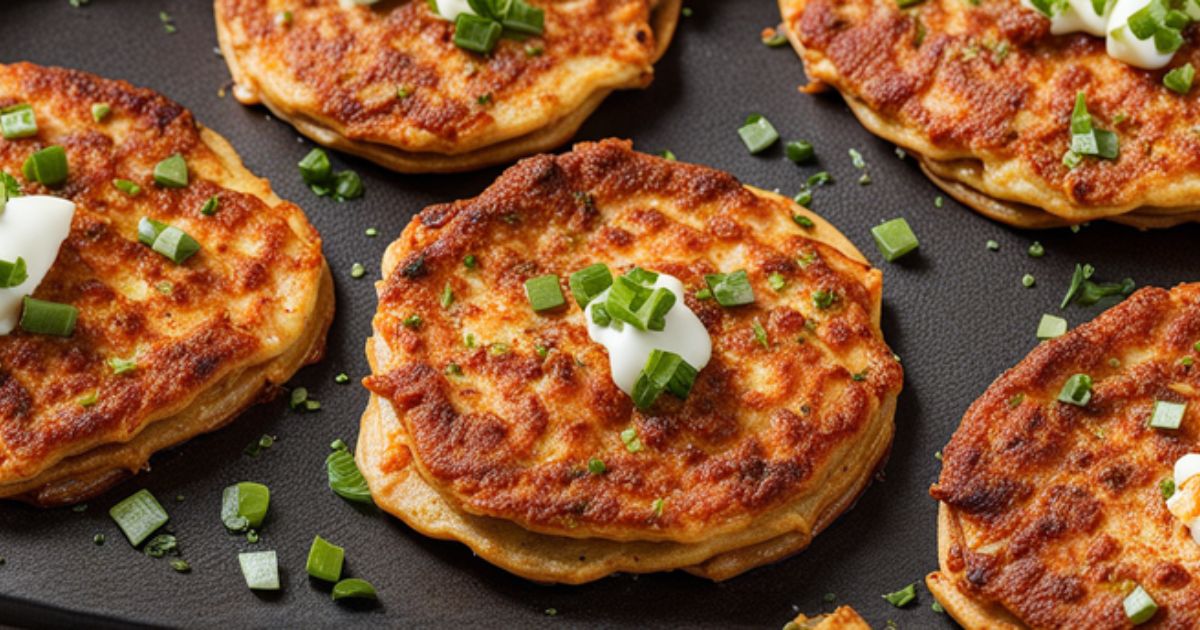
Kimchi Pancake Dipping Sauce Recipe

Here are some delicious kimchi pancake sauce options to complement your crispy and delicious kimchi pancakes:
1. Classic Dipping Sauce:
Mix the following ingredients in a small bowl:
1 tablespoon of soy sauce
1 tablespoon of rice vinegar
1 tablespoon of water
1 tablespoon toasted sesame oil (optional)
A pinch of salt and pepper
Sesame seeds (optional, for garnish)
Serve this tangy and savory sauce alongside your kimchi pancakes.
2. Spicy Dipping Sauce:
For an extra kick, add:
1-2 tablespoons gochujang (Korean chili paste) or gochugaru (Korean red chili flakes) in a classic dipping sauce.
Adjust the spiciness to your liking.
Gochujang adds depth and umami to the sauce.
3. Quick Soy-Vinegar Dipping Sauce:
– Collect:
1 tablespoon of soy sauce
1 tablespoon of rice vinegar
Water splash
A pinch of sugar (optional)
Mix well and adjust the taste as needed.
This simple sauce pairs wonderfully with kimchi pancakes.
The dipping sauce enhances the overall experience, so feel free to customize it based on your taste preferences. Enjoy your crispy kimchi pancakes with these delightful sauces.
Conclusion:
Kimchi pancakes, originating in the Korean home kitchen, are a culinary innovation that blends tradition with modernity, captivating the senses and warming the heart. Their widespread popularity on the global food scene inspires food enthusiasts around the world, making them a true celebration of taste, tradition and the joy of good food.
FAQ
1. What are kimchi pancakes made of?
- Kimchi pancakes are made from kimchi, flour, water, eggs, scallions and seasonings.
2. What do you eat kimchi pancakes with?
- Kimchi pancakes can be enjoyed on their own or paired with dipping sauces such as soy sauce, spicy gochujang, or vinegar-based sauces. They also complement other Korean dishes or can be served as part of a meal with rice and side dishes.
3. Why aren’t my kimchi pancakes crispy?
- Too much moisture in the batter, not enough oil in the pan, low cooking temperature or flipping it too early can cause your kimchi pancakes to not be crispy.
4. Is it okay to eat kimchi every day?
- Eating kimchi every day is generally okay for most people. It is rich in probiotics, vitamins and antioxidants, which support gut health and overall well-being. However, moderation is key because of its sodium content, and people with sodium-sensitive conditions should be careful.

